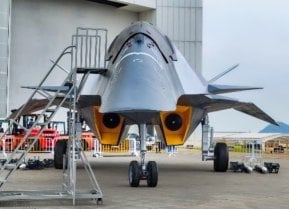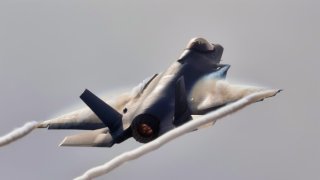The Houthis Are Freaked: F-35C Fighters Just Drew 'First Blood'
The U.S. Navy’s F-35C Lightning II stealth fighter recently saw its first combat action in a series of airstrikes against Houthi rebel weapons storage sites in Yemen.
What You Need to Know: The U.S. Navy’s F-35C Lightning II stealth fighter recently saw its first combat action in a series of airstrikes against Houthi rebel weapons storage sites in Yemen.

-Operating as part of a U.S.-led international task force, the carrier-based F-35C targeted facilities used by Iranian-backed Houthi forces to disrupt Red Sea and Gulf of Aden maritime traffic.
-This debut combat mission, supported by B-2 Spirit bombers and other assets, showcases the F-35C’s capabilities, specifically designed for carrier landings.
-With further potential for a larger Indo-Pacific role, the F-35C’s deployment experience strengthens U.S. readiness in strategic regions.
The F-35C Is Now Going to War Against the Houthis
The “C” version of the F-35 Lighting II stealth fighter jet drew first blood over the weekend during a series of targeted airstrikes against Houthi rebel targets in Yemen.
The Iranian-backed Houthis have been attacking commercial shipping in the Red Sea and Gulf of Aden for months.
The F-35C is the most exclusive version of the stealth fighter jet and is designed for a single purpose: to operate from aircraft carriers.
First Blood: The F-35C In Combat
The U.S. military is leading an international task force in the Red Sea and Gulf of Aden to counter the aggression of the Houthis, who are backed by Iran with weapons and Russia with intelligence.
As part of this task force, the F-35C Lightning II conducted its first combat missions against a series of Houthi targets in Yemen. The carrier-based stealth fighter jet targeted Houthi weapon stocks.
“U.S. Central Command [CENTCOM] forces executed a series of precise airstrikes [on] November 9 through 10 on multiple Houthi weapons storage facilities situated within Houthi-controlled territories in Yemen,” Pentagon Press Secretary Air Force Maj. Gen. Patrick Ryder said during a press briefing on Monday.

“These facilities housed a variety of advanced conventional weapons used by the Iran-backed Houthis to target US and international military and civilian vessels navigating international waters in the Red Sea and Gulf of Aden,” Maj. Gen. Ryder added.
The F-35C strikes against the Houthis come soon after another series of precision strikes by B-2 Spirit strategic stealth bombers.
“The operation involved U.S. Air Force and U.S. Navy assets, to include F-35C fighter aircraft,” Ryder stated, accidentally omitting the participation of the Marine Fighter Attack Squadron 314 (VMFA-314), the “Black Knights,” that flew the F-35Cs into combat.
With approximately 3,542 orders for all three variants of the F-35 Lightning II by 19 countries, only the U.S. Navy and U.S. Marine Corps have ordered and are flying the F-35C. And for a good reason: the aircraft is designed to operate from aircraft carriers. It sports a stronger structure and landing gear that can withstand the extreme pressures of carrier landing operations. Other than that, the “C” version shares almost exactly the same combat capabilities and performance as the “A” and “B” versions.

The Navy has ordered 273 F-35Cs, while the Marine Corps has 67 (and 353 F-35Bs).
In a potential conflict with China in the vast Indo-Pacific theater of operations, the F-35C would be at the forefront of operations. So, this combat experience its crews and maintainers get could pay dividends down the road.
The F-35 Lightning II
The F-35 Lightning II is a fifth-generation, multi-role stealth fighter jet. It is the most advanced fighter jet in the skies today and can conduct Air Superiority, Close Air Support, Strategic Attack, Electronic Warfare, Intelligence, Surveillance, and Reconnaissance (ISR), Suppression of Enemy Air Defenses (SEAD), and Destruction Enemy Air Defense (DEAD).
The stealth fighter jet comes in three variants: the F-35A, the conventional take-off and landing version; the F-35B, which is a Short Take-off, Vertical Landing (STOVL) aircraft; and the F-35C, which is designed for carrier operations.
About the Author
Stavros Atlamazoglou is a seasoned defense journalist specializing in special operations and a Hellenic Army veteran (national service with the 575th Marine Battalion and Army HQ). He holds a BA from the Johns Hopkins University and an MA from the Johns Hopkins’ School of Advanced International Studies (SAIS). His work has been featured in Business Insider, Sandboxx, and SOFREP.
Image Credit: Creative Commons.


